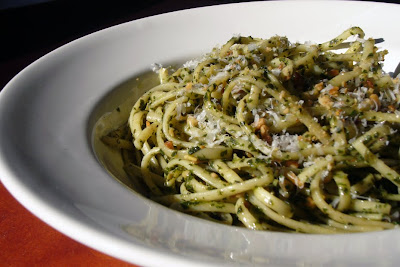
Ingredients
2 1/4 cups tightly packed basil leaves, washed and dried thoroughly
2 cloves garlic
about 1/3 cup extra virgin olive oil
sea salt
freshly cracked black pepper
about 1/4 cup pine nuts
parmiggiano-reggiano (or grana padano) cheese
linguine (or any type of pasta), fresh if possible
Instructions
Toast the pine nuts over medium heat until golden brown. Be careful as they near the end of cooking, as they tend to burn quickly. Crush with a mortar and pestle, or with the back of a knife, and set aside.
Puree the basil, 1/4 cup of olive oil, and garlic in a food processor. Add more olive oil, salt, and pepper in small increments, tasting after each addition, until the sauce tastes good to you. Remember to make it a little stronger than you think is necessary, because it will be somewhat diluted when you add the pasta. Also, be careful not to add too much oil. If you do, the sauce doesn't absorb into the sauce quite as well. Pour into a deep bowl and mix in the nuts. Some recipes recommend blending the nuts with the sauce, but we prefer to add them later to preserve their texture.
Boil your pasta until al dente. Move about a tablespoon of the cooking water to the bowl of pesto before you drain the pasta. After well drained, add the pasta to the pesto and top with an extremely generous portion of grated parmiggiano-reggiano cheese and mix until pasta is coated.
The easiest way to improve your pesto is to use high-quality olive oil. In fact, a good (and usually expensive) bottle of olive oil is always good to have around to supplement a less expensive bottle used for cooking. We started using Palestinian oil and haven't looked back.
If you are really serious about pesto, you can use a mortar and pestle instead of a food processor. Crushing each leaf by hand breaks down the fibers and tends to make a more flavorful sauce. But be warned, you might be too tired to eat by the time you are done.

Ottima la pasta con il pesto, semplice e gustosa.
ReplyDeleteCiao Daniela.
a Genovese would not have done of better.
ReplyDeleteCiao Alessandra